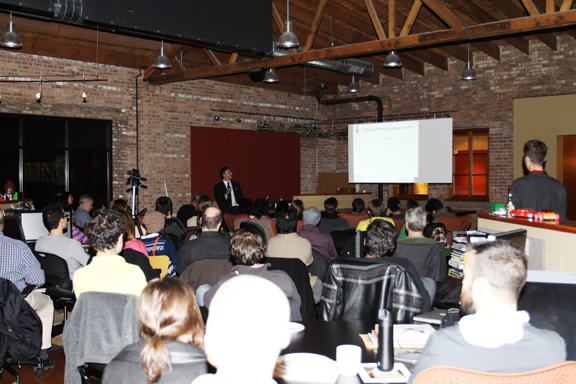Beyond Design and IDSA-Chicago Host Event on Design Patents
We hosted an event with IDSA-Chicago at our studio on Monday, November 12th, and had an amazing turnout! Special thanks to our guest presenter, Chris Carani, for taking time out of his busy schedule to discuss design patents and share his insight as to what designers and businesses should know about IP going forward.
Chris, a partner and shareholder at the intellectual property law firm of McAndrews, Held & Malloy, Ltd. based in Chicago, spent time discussing the background of design and utility patents, as well as “the most high profile, intellectual property case of all time – Apple v. Samsung.” A number of designers have followed this case closely because it relates so much to what we do every day. In the Apple v. Samsung case, there were four key designs at play, three of which were more traditional industrial design and one which implicates graphic user interface.
“The graphic user interface design is the one that intrigues me the most. This is the one that I think is sort of the future. As you can see here (referring to the black and white patent drawing of the iPhone), Apple had a more generic design claim in their black and white drawing. Interestingly enough, this middle row was absent (referring to the line above the bottom row). I think that becomes a bigger deal, when you claim less, having that absence of a row becomes a big deal. In the end, they went for it with the color version (as opposed to the black and white). It goes with the notion: if you claim more (the color and all aspects of it) there is more room for differences to be absorbed.”
This was the first case with a design patent directed at GUI. Since this case, the U.S. Patent office has had a 700% increase with respect to design patents for graphic user interface. With everything turning digital and so many apps and interfaces being created on a daily basis, it’s no surprise that people are becoming more cautious of what should and should not be patented with respect to GUI.
Chris mentioned that last year alone, Samsung filed 333 design patents, the most of any applicant in the United States. One of the key differences in how Apple went about filing patents versus Samsung is the amount of design patents per product. While 333 seems like a lot, when you consider how many products Samsung designs it makes it seem significantly less. Apple, on the other hand, uses the strategy of filing a number of design patents for just one product.
“There seems to be some mixed feelings about this decision. Some people say it’s too far and will siphon innovation, while other people like it. For many years, I’ve heard that there is not enough protection for designers. The fact that the pendulum swung the other way for designers, in my opinion, is probably a good thing. Maybe this is a little too far to the right, but by and large, I think it will show the courts that these rights should be respected…You’re seeing both individual designers all the way up to large corporations, taking a second, harder look at design because of this case.”
Some other basic things that are important to note about IP law, aside from the Apple v. Samsung case, are the differences between design and utility patents and how exactly you can protect appearance.
A utility patent protects the way something works and is valid for 20 years. Whereas, a design patent protects the overall industrial design, a portion thereof, or the graphic user interface and is valid for 14 years.
Chris outlined three ways to protect appearance: trade dress, copyright, and design patent.
“A great example of trade dress is the Coca Cola bottle. Aside from logo or name, the shape of something is an indicator of source. It doesn’t have an expiration date. That shape has to become synonymous with that source. It takes many years to get that type of association with a shape.”
As a designer or business professional, a key thing to remember about design patents is that they must be novel, non-obvious, and ornamental. Ornamental, in this case, means that it has an overall distinct appearance that is not dictated by the function of the product.
Carani has published and lectured extensively on the topic of design law and is a frequent contributor to CNN on intellectual property law issues. You can read more about Chris here.
Thanks again to all who attended! You can watch the full video from the event below. Enjoy!





 Top
Top
